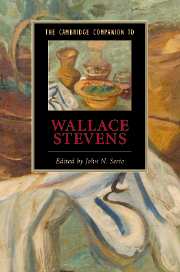Book contents
- Frontmatter
- Introduction
- 1 Wallace Stevens: A Likeness
- 2 Stevens and Harmonium
- 3 Stevens in the 1930s
- 4 Stevens and the supreme fiction
- 5 Stevens’ late poetry
- 6 Stevens and his contemporaries
- 7 Stevens and romanticism
- 8 Stevens and philosophy
- 9 Stevens’ seasonal cycles
- 10 Stevens and the lyric speaker
- 11 Stevens and linguistic structure
- 12 Stevens and painting
- 13 Stevens and the feminine
- 14 Stevens and belief
- Further reading
- Index
2 - Stevens and Harmonium
Published online by Cambridge University Press: 28 May 2007
- Frontmatter
- Introduction
- 1 Wallace Stevens: A Likeness
- 2 Stevens and Harmonium
- 3 Stevens in the 1930s
- 4 Stevens and the supreme fiction
- 5 Stevens’ late poetry
- 6 Stevens and his contemporaries
- 7 Stevens and romanticism
- 8 Stevens and philosophy
- 9 Stevens’ seasonal cycles
- 10 Stevens and the lyric speaker
- 11 Stevens and linguistic structure
- 12 Stevens and painting
- 13 Stevens and the feminine
- 14 Stevens and belief
- Further reading
- Index
Summary
Harmonium is Wallace Stevens' first book. He had started writing poems seriously when he was a student at Harvard (1897-1900) and made a new start in 1907 when he began composing poems for Elsie Kachel, whom he later married. For Harmonium he chose seventy-four poems, but none that he had written before 1914 or 1915 (dates of composition are approximate for Stevens; what we know are the dates of publication). Between 1914 and 1919, Stevens had published thirty-nine poems that he included neither in Harmonium (1923) nor in The Collected Poems (1954). On December 21, 1922, he wrote to Harriet Monroe concerning the selection he made for Harmonium: “I have omitted many things, exercising the most fastidious choice, so far as that was possible among my witherlings. To pick a crisp salad from the garbage of the past is no snap” (L 232). Although he waited until he was nearly forty-four to publish his first book, Stevens had been considering collecting his poems for a number of years.
On April 9, 1918, he wrote to William Carlos Williams to congratulate him on the publication of Al Que Quiere! (1917), his third book of poems. He had met Williams in 1915 among the group of writers and painters who gathered that summer in Grantwood, New Jersey, on Sunday afternoons and were associated with Alfred Kreymborg's magazine, Others. Stevens had hesitated to send the letter, and adds in the upper left corner: “I think, after all, I should rather send this than not, although it is quarrelsomely full of my own ideas of discipline.”
- Type
- Chapter
- Information
- The Cambridge Companion to Wallace Stevens , pp. 23 - 36Publisher: Cambridge University PressPrint publication year: 2007



